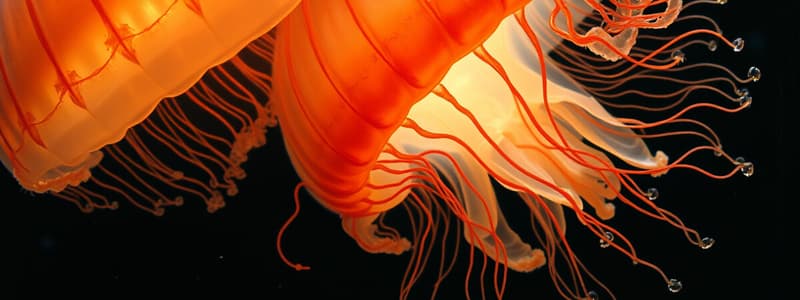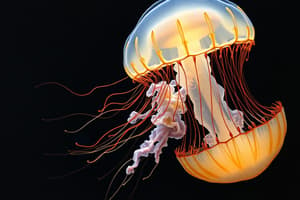Podcast
Questions and Answers
What is another name for ctenophores, and what phylum do they belong to?
What is another name for ctenophores, and what phylum do they belong to?
Ctenophores or comb jellies; phylum Ctenophora.
What shape are comb jellies?
What shape are comb jellies?
Spherical or oval.
How are comb jellies different from jellyfish?
How are comb jellies different from jellyfish?
They lack nematocysts and do not sting.
What is the habitat of ctenophores?
What is the habitat of ctenophores?
How do comb jellies move?
How do comb jellies move?
How many rows do the comb plates of comb jellies have?
How many rows do the comb plates of comb jellies have?
Are comb jellies good swimmers?
Are comb jellies good swimmers?
What is the symmetry of comb jellies, and what level of organization are they on?
What is the symmetry of comb jellies, and what level of organization are they on?
What is the tissue structure of comb jellies composed of?
What is the tissue structure of comb jellies composed of?
Where are the myoepithelial cells of comb jellies located?
Where are the myoepithelial cells of comb jellies located?
How many tentacles do comb jellies have, and where are they kept?
How many tentacles do comb jellies have, and where are they kept?
Do comb jellies have tentacle sheaths?
Do comb jellies have tentacle sheaths?
What are the threadlike filaments of comb jellies called, and where are they located?
What are the threadlike filaments of comb jellies called, and where are they located?
What are glue cells, and what is their function?
What are glue cells, and what is their function?
How do comb jellies feed?
How do comb jellies feed?
What are collocytes?
What are collocytes?
How do comb jellies typically swim?
How do comb jellies typically swim?
Do comb jellies glow in the dark?
Do comb jellies glow in the dark?
How do comb jellies reproduce, sexually or asexually, and are they monoecious or dioecious?
How do comb jellies reproduce, sexually or asexually, and are they monoecious or dioecious?
What type of larva do comb jellies produce, and what shape are they?
What type of larva do comb jellies produce, and what shape are they?
Name two classes of comb jellies.
Name two classes of comb jellies.
Describe Class Tentaculata and give an example.
Describe Class Tentaculata and give an example.
Describe Class Nuda.
Describe Class Nuda.
Flashcards are hidden until you start studying
Study Notes
Ctenophores Overview
- Commonly known as comb jellies, ctenophores belong to the phylum Ctenophora.
- Exhibit spherical or oval body shapes.
- Unlike jellyfish, they lack nematocysts and do not sting.
Habitat and Movement
- All ctenophores are marine organisms.
- Utilize ctenes, or comb plates, for locomotion, composed of partially fused cilia.
- Most species have their ctenes arranged in 8 rows.
- Generally considered feeble swimmers; often found floating rather than actively swimming.
Symmetry and Tissue Structure
- Display biradial symmetry and have a tissue level organization with minimal organ development.
- Body wall consists of three layers: epidermis, mesoglea, and gastrodermis; thick mesoglea contains collagen fibers and muscle cells along with amoeboid cells.
Tentacles and Feeding Mechanics
- Most species possess two tentacles, which are connected to a pouch known as a tentacle sheath allowing for retraction.
- Tentilla, threadlike filaments on tentacles, assist in predation.
- Collocytes, the glue cells on tentacles, aid in capturing zooplankton.
- They feed by wiping tentacles against the mouth, with excess and indigestible particles expelled through anal pores and the mouth.
Reproductive Systems and Larvae
- Primarily reproduce sexually; most species are monoecious, with external fertilization.
- Produce cydippid larvae, characterized by a spherical to oval shape.
Classification of Ctenophores
- Two main classes: Class Tentaculata and Class Nuda.
- Class Tentaculata: Contains tentacles; example includes the sea gooseberry, capable of retracting tentacles into sheath.
- Class Nuda: Lacks tentacles but features a wide mouth.
Bioluminescence
- Many species exhibit luminescence, emitting flashes of light at night utilizing specialized light-producing cells called photocytes.
Studying That Suits You
Use AI to generate personalized quizzes and flashcards to suit your learning preferences.




